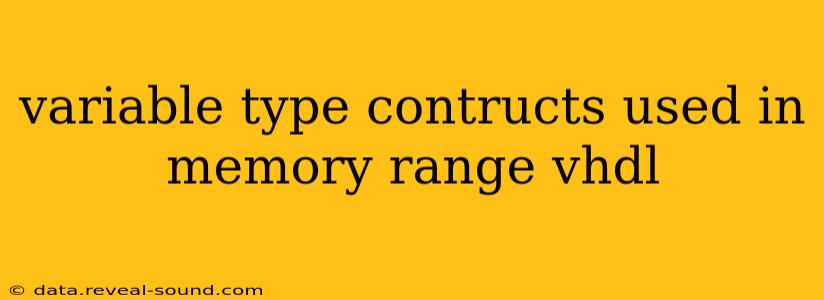Variable Type Constructs Used in Memory Range VHDL
VHDL (Very-high-speed integrated circuit Hardware Description Language) offers several ways to declare and use variables within a specified memory range. Understanding these constructs is crucial for efficient and accurate memory management in your designs. This article will explore the common variable types and how they're utilized for memory addressing in VHDL. We'll also address some frequently asked questions surrounding this topic.
What are the common variable types used for memory in VHDL?
VHDL primarily uses arrays and records to represent memory ranges. Let's break them down:
1. Arrays:
Arrays are the most straightforward way to represent memory. They consist of a collection of elements of the same type, accessed via an index. For memory representation, the index typically represents the memory address.
type mem_type is array (0 to 1023) of std_logic_vector(7 downto 0); -- 1KB memory of 8-bit words
signal my_memory : mem_type;
In this example, my_memory is a signal representing a 1KB memory block. Each element is an 8-bit std_logic_vector. You access individual memory locations using the index:
my_memory(512) <= x"FF"; -- Write 0xFF to address 512
y <= my_memory(100); -- Read data from address 100
You can use any appropriate integer type for the array index range, defining the memory size and addressing scheme.
2. Records:
Records are useful when you need to store different data types within a single memory location. Each element within a record has a unique name, making the code more readable and maintainable.
type mem_data_type is record
data : std_logic_vector(7 downto 0);
valid : std_logic;
end record;
type memory_type is array (0 to 255) of mem_data_type; -- 256 entries of data and a valid bit
signal my_memory : memory_type;
Here, each memory location (my_memory(i)) contains an 8-bit data value and a valid bit indicating data validity. Access is done via record element names:
my_memory(10).data <= x"A5";
my_memory(10).valid <= '1';
How do I initialize memory in VHDL?
You can initialize memory either during declaration or using an initialization process.
Declaration Initialization:
signal my_memory : mem_type := (others => (others => '0')); -- Initialize all memory locations to 0
This initializes all elements of my_memory to zero. others => ... is a VHDL shorthand for initializing multiple elements simultaneously.
Process Initialization:
process (reset)
begin
if reset = '1' then
for i in my_memory'range loop
my_memory(i) <= (others => '0'); -- Initialize each location individually
end loop;
end if;
end process;
This approach allows for more complex initialization logic, for example, loading data from a file or other sources.
What about multi-dimensional arrays for representing matrices or more complex memory structures?
VHDL supports multi-dimensional arrays which can be used to represent matrices or more complex data structures.
type matrix_type is array (0 to 31, 0 to 31) of std_logic; -- 32x32 matrix
signal my_matrix : matrix_type;
my_matrix(10, 5) <= '1'; -- Accessing element at row 10, column 5
Are there any other considerations when working with memory ranges in VHDL?
Yes, several key considerations include:
- Memory Size: Carefully plan your memory size to avoid exceeding available resources on your target device.
- Data Types: Choose appropriate data types for your memory elements based on the data you're storing.
- Addressing Scheme: Select an appropriate addressing scheme based on your application requirements.
- Initialization: Ensure proper initialization of your memory to avoid unpredictable behavior.
- Synthesis Tools: Be aware that different synthesis tools might have different capabilities and limitations when handling large memory arrays.
By understanding these variable types and techniques, you can efficiently manage memory ranges within your VHDL designs, creating robust and optimized hardware implementations. Remember to always consult your specific synthesis tool's documentation for any platform-specific considerations.
